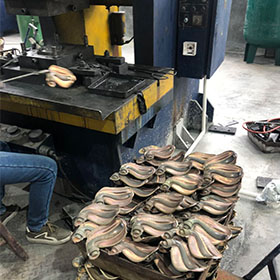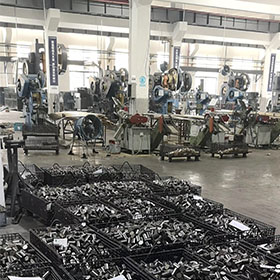Forging
Copper & Brass Forging
 At Gambo Industry, brass forgings from 0.01kg to 20kg can be made using this process.Hot forging of copper alloys can produce an almost limitless variety of 3-D shapes that range in weight from mere ounces. Hot copper forgings are routinely produced on hydraulic presses or mechanical presses and punch machines, with capacities up to 800tons.
At Gambo Industry, brass forgings from 0.01kg to 20kg can be made using this process.Hot forging of copper alloys can produce an almost limitless variety of 3-D shapes that range in weight from mere ounces. Hot copper forgings are routinely produced on hydraulic presses or mechanical presses and punch machines, with capacities up to 800tons.
During copper forging process, two or more dies containing impressions of the part shape are brought together so that copper forging billet undergoes plastic deformation under high pressure and high or room temperature. When the upper and lower dies touch each other, metal flow is restricted by the die contours, so our copper forging process can make copper forgings with complex shapes and closer tolerances, no matter the final shape is symmetrical or non- symmetrical shapes.
 Copper forgings with symmetrical shapes are like coupling, finger, handle, tee, ect. Besides, there are also some non-symmetrical shaped copper forgings, such as valve fittings, taps and other customs copper components. The whole copper forging process seems complex, but very quick, and can be suitable for both small and large production runs.
Copper forgings with symmetrical shapes are like coupling, finger, handle, tee, ect. Besides, there are also some non-symmetrical shaped copper forgings, such as valve fittings, taps and other customs copper components. The whole copper forging process seems complex, but very quick, and can be suitable for both small and large production runs.
In terms of alloys used in copper forging process, they can be classified in red copper alloys, brass alloys and bronze alloys. Red copper alloys are C11000, C12000, C10100, C10200, ect. Due to the high copper content, this type of copper forgings are the most expensive.
Brass forging alloys include: C37700, C36000, C37100,ect. For its less copper content than red copper, brass forgings are the most widely used in industrial applications. The last type of copper forging alloy is Bronze alloy, include C83600, C95400, ect.
The last process capability is the tolerance controlled in copper forging process. The general forging tolerance is normally at a range of ±0.25mm~±0.5mm, which is mainly decided by the weight & dimensions. Besides, the precison of forging dies will also affect the tolerance of copper forgings. The more precise the forging dies, the smaller the tolearance will be.